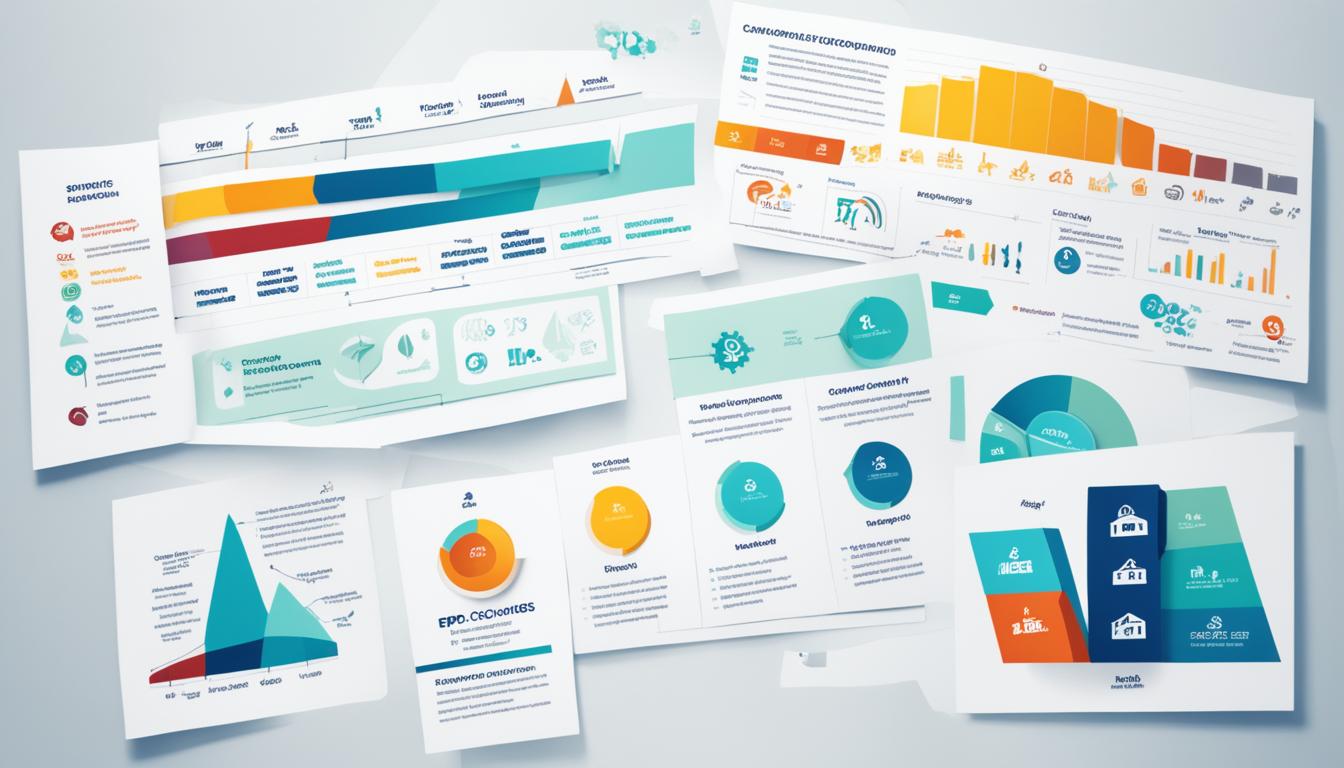In marketing, a good product mix is key to success. It is the total of products your business offers. This includes all product lines and marketing offerings. They are important in your marketing strategy.
Let’s talk about your product mix’s length, breadth, depth, and consistency. Length is all about the number of products. Breadth is about your product lines. Depth looks at variations in each line. Consistency shows how your lines relate to each other.
A product mix is crucial because it meets diverse customer needs. This builds loyalty. It keeps your brand strong and focuses on your core products. Plus, it makes managing inventory easier.
It’s key to know “product mix” and “product line” are not the same. A product mix is everything you offer. A product line is a specific type within your mix.
Understanding a product mix’s value is step one. Let’s look closer at its parts, benefits, and how to make it better.
Key Takeaways:
- A product mix includes all products a business offers, like different product lines.
- Its parts are length, breadth, depth, and consistency.
- A solid product mix helps businesses meet many customer needs, keep a strong brand, and manage inventory well.
- Use strategies like expanding, contracting, deepening, altering, trading up, and down to improve your product mix.
- Looking at competitors’ product mixes can give you ideas to improve yours.
Components of a Product Mix
The parts of a product mix are vital for a company’s market stance and offerings. These include product lines, length, breadth, depth, and consistency. Here is a closer look at each part:
Product Lines
Product lines are sets of similar products a company sells. They fit specific customer needs or market segments. Diverse product lines help companies attract more customers and secure a bigger market.
Length
The length shows how many products a company has. This reflects the company’s variety and scale. A longer mix means more options for customers, meeting their tastes and needs better.
Breadth
Breadth is about how many product lines a company has. It shows a company’s reach in different markets and to various customers. A wider breadth lets a company appeal to more people, gaining more of the market.
Depth
Depth is the variety within a product line. It’s about the different versions or options of a product available. More depth means customers can find products that suit their needs closely within a line.
Consistency
Consistency deals with how product lines relate in use, making, and selling. It keeps product lines aligned, ensuring a unified brand image and smooth customer experience. This also streamlines making, managing, and distributing products.
Knowing and managing these parts lets companies tailor their product mix. This meets customer desires, boosts brand value, and grows the business.
Benefits of a Well-Maintained Product Mix
A well-maintained product mix brings several advantages to businesses. It lets them provide many products to meet diverse customer needs. This variety increases customer loyalty and limits sales losses to competitors. It also strengthens the brand image by showing the business meets customer demands well.
Keeping a strong product mix helps businesses focus on what they’re best at. They can concentrate on their main products and use their resources wisely. This way, businesses don’t weaken their brand. They ensure their products reflect their expertise and value.
Also, a good product mix is vital for managing inventory well. It allows businesses to keep the right amount of stock. This reduces the chance of running out or having too much. Lower inventory costs and less waste improve business operations.
In short, a good product mix offers businesses many benefits. It lets them offer various products, boosts their brand, keeps them focused, and helps manage inventory. By knowing what customers want and updating their products, businesses can stand out and improve their market position.
Strategies to Optimize a Product Mix
Companies use many tactics to perfect their product mix. These methods depend on their goals and needs. They help meet customer wants and boost profits.
Expansion
Expansion means adding to the product lines and bringing in related new products. It helps a company reach new people. It also makes the brand stronger.
This approach meets changing customer needs. It leads to growth and more money.
Contraction
Contraction involves getting rid of products that don’t sell well. It helps a business focus on what works. This method makes inventory and expenses better.
It means focusing on products that customers really like.
Deepening
Deepening adds more types to a current product line. It offers customers more choices. This can make customers happier.
It also helps in selling more to each customer. This can lead to customers spending more over time.
Alteration
Alteration improves products based on feedback or trends. It keeps a business competitive. It also keeps customers coming back.
Trading Up and Trading Down
Trading up adds pricier items for those who don’t mind spending more. It can make more profit. Trading down brings in cheaper items for those watching their budget.
Choosing the best strategy depends on the company’s goals. It means looking at trends, customer wants, and competition. The right mix meets consumer needs, raises profits, and improves market stance.
Product Mix Analysis
An analysis of the product mix is key for picking the best products for a business. This review is done at different levels to meet the needs of various markets. It looks at customer, regional, and national levels.
Starting a product mix analysis means picking a scenario to explore. This choice might be based on market needs, what customers like, or new trends. With a clear scenario, companies can zero in on their goals.
The next step is to plan for demand. Companies figure out which products or services people really want. They consider customer tastes, market data, and sales predictions to decide the market share for each product.
At the same time, it’s important to adjust the supply plan. This makes sure the business can offer what customers want. The plan involves looking at how to produce items, where to get materials, and how to manage stock.
After setting up demand and supply plans, companies can tweak their product mix. They evaluate different sales strategies and consider what resources they have. Then, they decide what their product mix should look like.
The results of tweaking the product mix soon show in the business’s finances. This analysis shows how changing the mix can boost sales, grab more market share, and raise profits.
Doing a deep dive into the product mix gives businesses important insights. They learn about their products and see new chances for growth. This helps them decide on new products, marketing, and where to use resources in line with their main goals.
Example Product Mix Analysis
Imagine a tech company focusing on smartphones and laptops notices fewer people want their basic phones due to cheaper options from rivals. To improve their line-up and financial results, they decide to analyze their product mix.
| Product Category | Description | Demand Plan | Supply Plan |
|---|---|---|---|
| Smartphones | High-end smartphones with advanced features | Increase production to meet growing demand | Expand production facilities and secure reliable suppliers |
| Laptops | Powerful and lightweight laptops for professional use | Steady demand with potential for growth | Invest in cutting-edge technology and streamline production processes |
| Entry-level smartphones | Basic smartphones targeting price-sensitive customers | Phase out production due to declining demand | Allocate resources to other product categories |
Based on their analysis, the company decides to focus on high-end smartphones and laptops. These are more likely to make money and meet what customers want. By stopping production of less popular smartphones, the company can use its resources better.
In the end, this analysis helps the company make informed choices. They can adjust their products, change their focus, and maximize profit in the tough tech market.
Analyzing Competitor’s Product Mix
Studying a competitor’s product mix can give businesses important insights. It helps them understand the market better. It also shows where they can improve their own products.
First, decide what you want to achieve, like finding new markets. Then, figure out if competitors are direct, indirect, or replacement types.
Direct competitors target the same customers with similar products. Indirect competitors aim for a different group but still compete for the same money. Replacement competitors offer alternative choices to your products.
Next, look closely at what your competitors offer. Check out their product quality, prices, how they package, promote, and sell. By comparing, you can see where you might do better.
Learn how rivals promote their products. This can help shape your marketing. It might also show where you can offer something new or better. You can find market gaps or niches to explore.
Understanding what competitors offer is key in planning your products. It keeps you up to date with trends, customer likes, and how to stand out.
Comparison of Competitor’s Product Mix
| Competitor | Product Lines | Audience Segments |
|---|---|---|
| Company A | Product Line A, Product Line B | Audience Segment X, Audience Segment Y |
| Company B | Product Line C, Product Line D | Audience Segment Y, Audience Segment Z |
| Company C | Product Line E, Product Line F | Audience Segment X, Audience Segment Z |
Examples of Product Mixes
Trader Joe’s, Apple, and Amazon are top examples of diverse and wide product mixes.
Trader Joe’s
Trader Joe’s offers unique and varied products. They focus on high-quality food items. Their mix includes global cuisines with organic and vegan choices.
Customers find international snacks and artisanal cheeses. This wide selection meets different tastes and dietary needs.
Apple
Known for innovation, Apple integrates its products seamlessly. The mix includes Macs, iPods, iPhones, and Apple Watches. They serve various customers with cutting-edge technology.
Apple’s mix proves their dedication to quality devices and services.
Amazon
Amazon offers a vast mix across many categories. Beyond being a huge online retailer, it provides business services and entertainment. Its array includes e-commerce and cloud computing.
Amazon’s approach means customers find everything in one place. This makes Amazon a global industry leader.
Diverse product mixes meet different customer needs. Trader Joe’s, Apple, and Amazon each have their focus. This variety is key to attracting and keeping customers.
| Company | Product Mix Categories |
|---|---|
| Trader Joe’s | Food products, organic options, vegan options |
| Apple | Mac computers, iPods, iPhones, Apple Watches, etc. |
| Amazon | Online retail, business services, entertainment, self-publishing |
Differences Between Product Mix and Product Line
“Product mix” and “product line” are often mixed up, but they differ. A product line is about similar products or services. The product mix includes all product lines a business has. So, a company’s product mix is made up of various product lines.
Product Line
A product line is a set of related products or services a company sells. They’re linked by target market, customer needs, or how they’re used. Take Apple, for instance. Its product line has Macs, iPhones, iPads, and Apple Watches. All these fulfill different needs but stay under the Apple brand.
Product Mix
The product mix, however, is the total range of products or services a business offers. It’s all about the product lines put together. For Apple, this includes devices, plus software, accessories, and services like iCloud and Apple Music. Here, the product mix shows all that Apple has for its customers.
Understanding product line and product mix differences matters for businesses. While a product line zeroes in on a certain kind of product or service, a product mix covers everything a company provides. Good management of both can help a business reach more customers, and improve its product strategies.
Importance of Product Mix
The product mix is key to a company’s brand image. It shows all the products or services a company offers. With a variety of products, a company can avoid putting all its eggs in one basket. This approach protects against market shifts and builds the brand as a go-to source.
Yet, adding too many unrelated products can hurt the brand. It might confuse customers about what the company stands for. Companies should add new products thoughtfully, making sure they match the brand and meet customer needs.
Having the right product mix also helps a company make more money. By keeping an eye on what customers want and market trends, a company can spot and fill gaps in its lineup. This leads to better sales and revenue. A smart product mix means meeting various customer needs well.
Let’s look at an example to see why managing the product mix matters:
Example: XYZ Corporation
XYZ Corporation first made its name with smartphones. This helped them become a leader in that market. But it also made them vulnerable to shifts in the smartphone market. So, they decided to broaden their product range.
They started offering smartwatches, tablets, and wireless earphones. This move reduced their reliance on just smartphones. It also showcased XYZ as a leader in tech solutions.
This wider product range boosted XYZ’s profits. It attracted more customers and increased market share. Selling related products also meant more chances to sell more items to each customer. Such moves clearly show how vital a diverse product mix is.
In conclusion, managing a diverse product mix carefully is crucial. It builds the brand, reduces risks, and increases profits.
Conclusion
Product mix is key in marketing and business plans. Understanding its parts and benefits helps companies meet customer needs and achieve goals. Strategies like expanding or contracting the mix can help businesses adjust based on market demands.
Learning from competitors’ product mixes is useful. By looking at the strategies of companies like Trader Joe’s, Apple, and Amazon, businesses can find ways to diversify their products. These brands show the variety that can exist in a product mix, from food to entertainment.
A good product mix is essential for a strong brand, happy customers, and profit. Businesses should keep evaluating and updating their mix. This keeps them competitive and meets changing customer needs.








